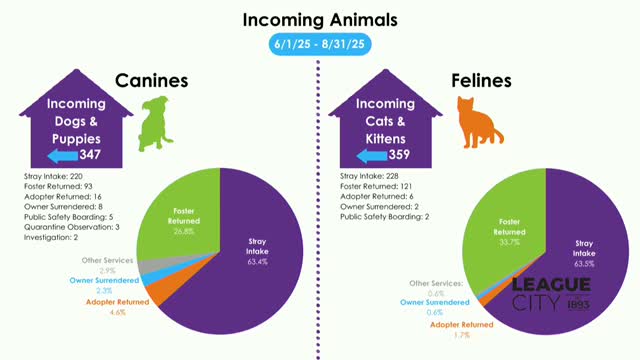Local Animal Shelter Reports High Adoption Rates and Successful Foster Programs
September 17, 2025 | League City, Galveston County, Texas
This article was created by AI summarizing key points discussed. AI makes mistakes, so for full details and context, please refer to the video of the full meeting. Please report any errors so we can fix them. Report an error »

The recent meeting of the League City Animal Shelter Advisory Committee highlighted significant trends in animal intakes and adoptions, reflecting both challenges and successes within the shelter. Over the past three months, the shelter reported a notable increase in animal intakes, with 347 dogs and 359 cats entering the facility. A majority of these animals were strays, although many kittens were returned from foster care, indicating a seasonal influx during neonate season.
The outgoing statistics were equally striking, with 355 dogs and 368 cats finding new homes. The adoption rate for dogs was particularly encouraging, with a substantial number being adopted, while the cat adoption rate stood at an even 50%. The remaining cats were either placed in foster care, returned to their homes, or, in a few unfortunate cases, euthanized or deceased.
In total, the shelter successfully adopted out 314 pets during this three-month period and placed nearly 200 animals into foster care. Additionally, 95 dogs participated in community outings, which not only provided them with socialization opportunities but also raised awareness about the shelter's mission. The shelter also reported 152 pets being returned to their homes and 58 community microchips and tags issued.
Despite these positive outcomes, the shelter is facing capacity challenges. As of the latest update, the shelter was operating at 21% over capacity for dogs, with some animals housed in crates or kennels not typically designated for them. The situation for cats remained more stable, with 34 cats in the shelter, aided by the quick adoption of kittens.
The committee discussed the importance of ongoing community engagement and the need for continued support to manage the shelter's capacity effectively. Moving forward, the shelter plans to include more detailed statistics in future reports, particularly regarding animal protection officer calls, to better inform the community about its operations and needs. The meeting underscored the vital role of the shelter in the community and the ongoing efforts required to ensure the well-being of its animal residents.
The outgoing statistics were equally striking, with 355 dogs and 368 cats finding new homes. The adoption rate for dogs was particularly encouraging, with a substantial number being adopted, while the cat adoption rate stood at an even 50%. The remaining cats were either placed in foster care, returned to their homes, or, in a few unfortunate cases, euthanized or deceased.
In total, the shelter successfully adopted out 314 pets during this three-month period and placed nearly 200 animals into foster care. Additionally, 95 dogs participated in community outings, which not only provided them with socialization opportunities but also raised awareness about the shelter's mission. The shelter also reported 152 pets being returned to their homes and 58 community microchips and tags issued.
Despite these positive outcomes, the shelter is facing capacity challenges. As of the latest update, the shelter was operating at 21% over capacity for dogs, with some animals housed in crates or kennels not typically designated for them. The situation for cats remained more stable, with 34 cats in the shelter, aided by the quick adoption of kittens.
The committee discussed the importance of ongoing community engagement and the need for continued support to manage the shelter's capacity effectively. Moving forward, the shelter plans to include more detailed statistics in future reports, particularly regarding animal protection officer calls, to better inform the community about its operations and needs. The meeting underscored the vital role of the shelter in the community and the ongoing efforts required to ensure the well-being of its animal residents.
View full meeting
This article is based on a recent meeting—watch the full video and explore the complete transcript for deeper insights into the discussion.
View full meeting
